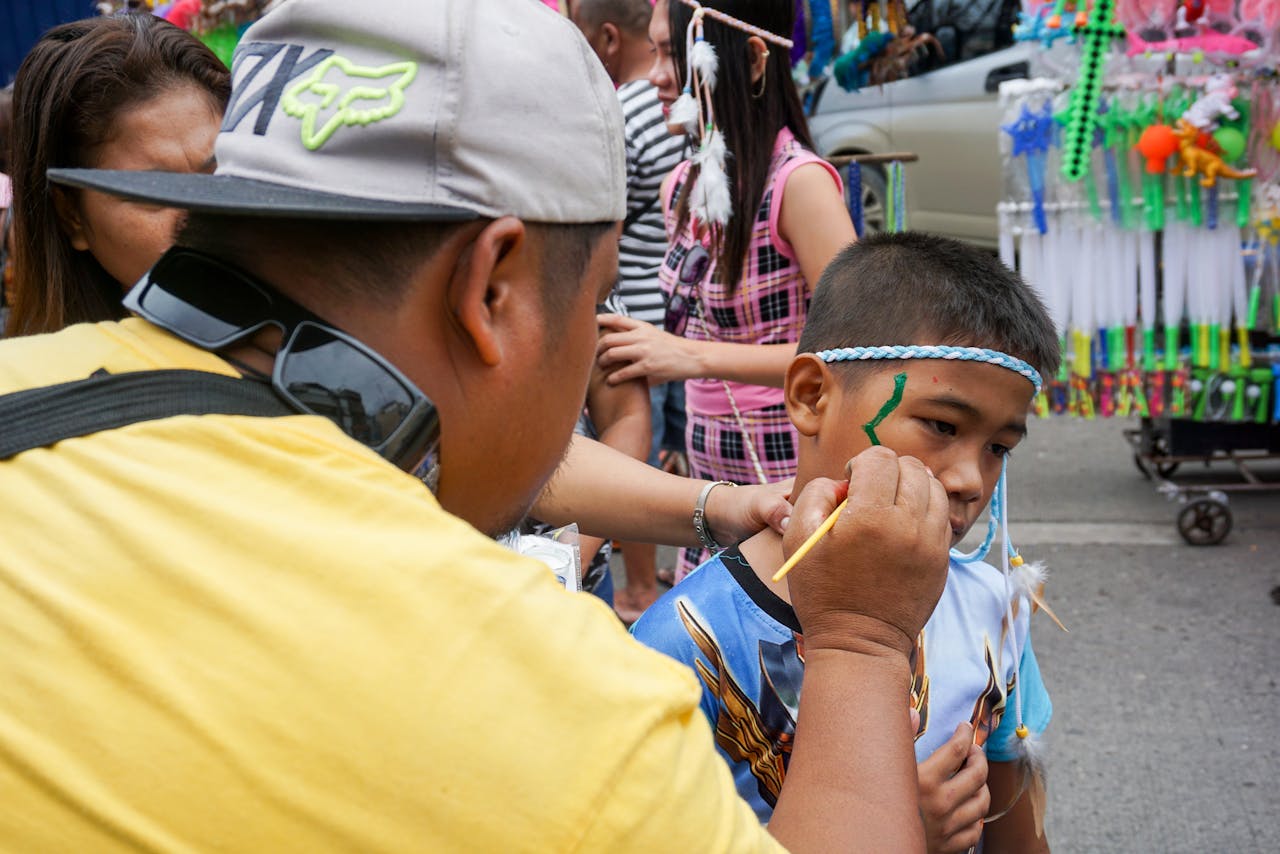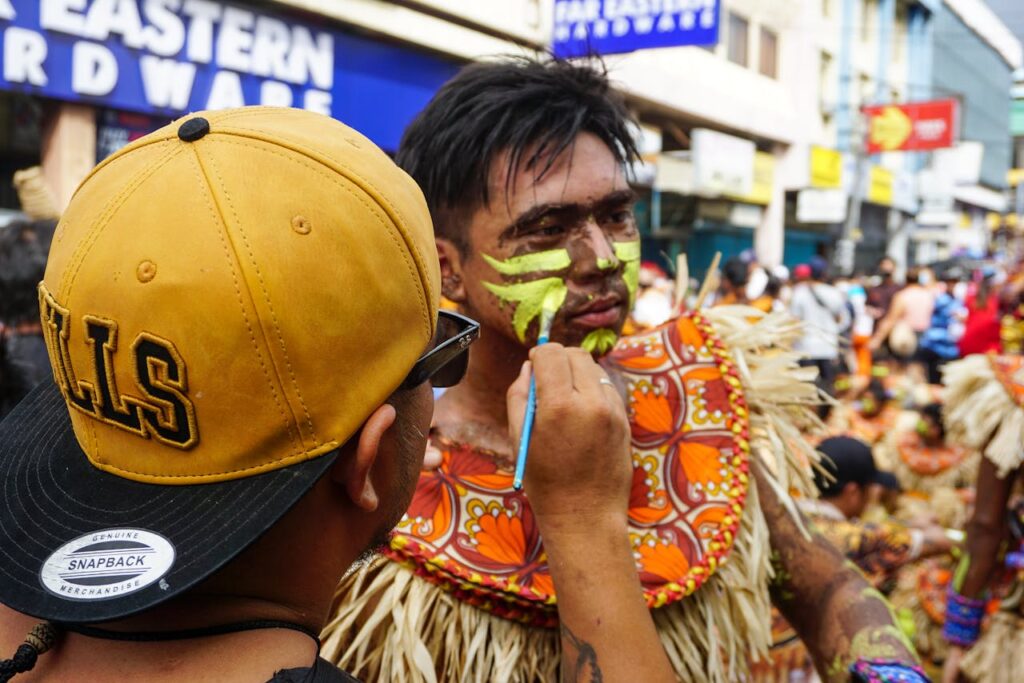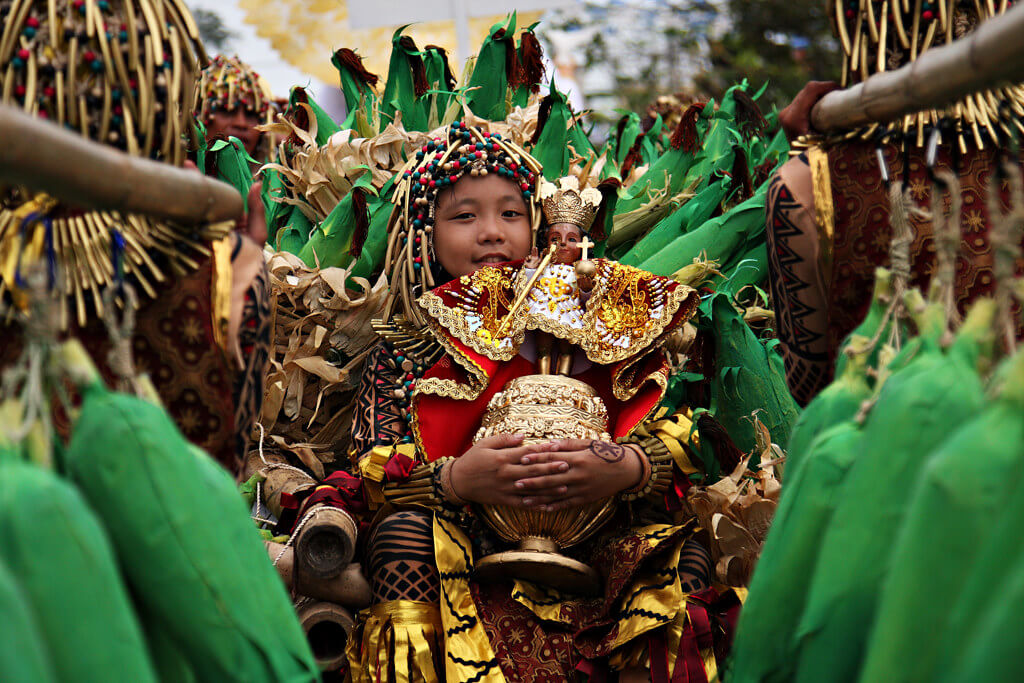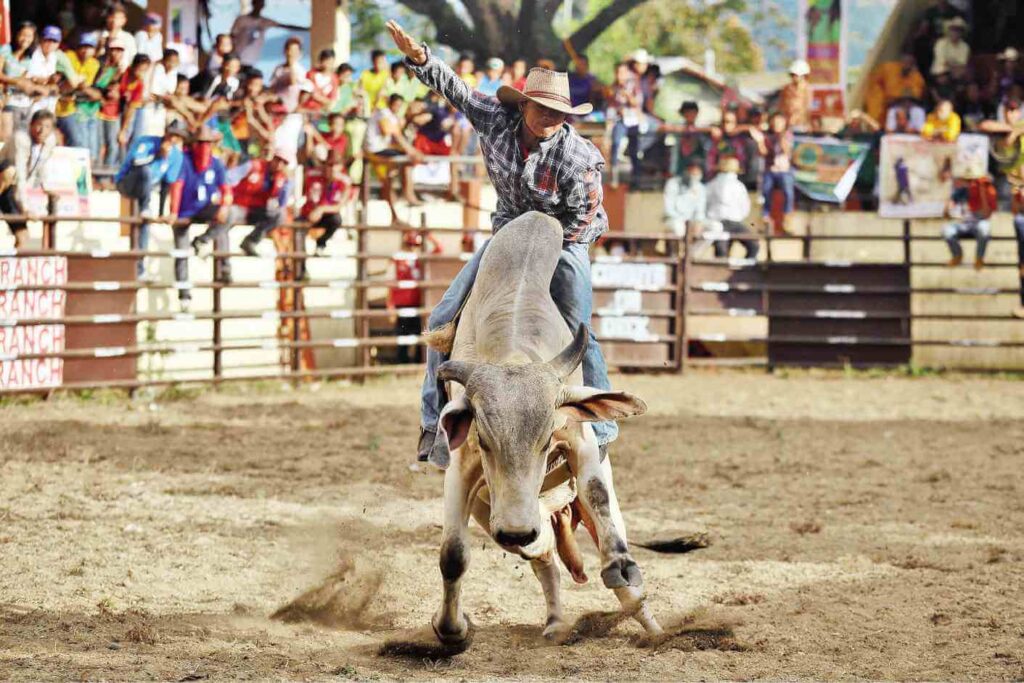Origins of Ati-Atihan Festival
The rich history of the Ati-Atihan Festival provides a fascinating backdrop to one of the most vibrant celebrations in the Philippines. Let’s dive into its origins, dating back to the 13th century, and the blending of indigenous and Catholic traditions that define this iconic event.
13th Century Migration to Panay
The roots of the Ati-Atihan Festival trace back to the 13th century, during a time of significant migration. Ten Malay chieftains, led by Datu Puti, fled from Borneo to escape the tyranny of Sultan Makatunaw. They, along with their families, embarked on a journey that led them to the shores of Panay Island (Pinas Culture).
Upon arriving, they encountered the indigenous Ati people, who were the original inhabitants of the island. A notable aspect of this migration was the peaceful trade and exchange that ensued. The Malay settlers offered precious gifts and, in return, were allowed to settle on the coastal plains. This event laid the foundation for the first Ati-Atihan—a feast symbolizing unity and cooperation between the two groups (Wikipedia).
| Event | Details |
|---|---|
| Migration Period | 13th Century |
| Key Figures | Ten Malay chieftains led by Datu Puti |
| Destination | Panay Island |
| Initial Encounter | Peaceful trade with Ati people |
Fusion of Indigenous and Catholic Traditions
The Ati-Atihan Festival’s evolution didn’t stop at the initial feast. Centuries later, Spanish missionaries arrived, bringing Catholicism to the Philippines. This cultural infusion significantly altered the festival’s character. The Ati-Atihan gradually adopted elements of Catholic celebrations, particularly the devotion to the Santo Niño (Holy Child) (Pinas Culture).
The modern Ati-Atihan Festival is now a unique blend of indigenous and Catholic traditions. While it retains its original essence of commemorating the peaceful coexistence between the Ati people and Malay settlers, it also incorporates religious elements, including processions and ceremonies dedicated to Santo Niño. This fusion is vividly displayed through the festival’s colorful parades, traditional dances, and symbolic costumes that participants wear.
For more insights into the specific elements of this event, check out our in-depth articles on ati-atihan festival costumes, ati-atihan festival music, and ati-atihan festival dance.
The Ati-Atihan Festival stands as a testament to the rich cultural mosaic of the Philippines, reflecting its history and the harmonious blending of disparate traditions.

Photo by Joel Garcia
Significance and Evolution
Fiesta de Santo Niño Connection
The Ati-Atihan Festival, known for its vibrant celebrations, traces a significant part of its roots to the Fiesta de Santo Niño. Dating back to the 17th century, this connection was part of the Catholic “fiesta system” employed by the Spanish colonial government (Roam Leisurely). The arrival of the Spanish in the 16th century introduced Christianity, merging the original pagan traditions of the Aetas with Catholic rituals. This blend honored the Santo Niño and included prayers, candle lighting, Mass attendance, and a nine-day novena before the main event.
The integration of the Santo Niño into the festival was a strategic move by the Spanish to convert the indigenous Ati people to Catholicism. This fusion of beliefs can still be observed today as the festival features both pre-colonial animistic practices and Christian elements. The Ati-Atihan has significantly influenced other festivals in the Philippines, such as the Dinagyang Festival in Iloilo and the Sinulog Festival in Cebu (Kalibo Aklan).
Commercialization and Cultural Influences
In the 1950s, the Ati-Atihan Festival underwent transformations that began to resemble celebrations like the Brazilian Carnival and Mardi Gras in New Orleans. These changes brought in elements such as music, street dancing, and body painting, adding a new dimension to the festival’s ambiance (Wikipedia).
By the 1960s, commercialization started to influence the festival. This led to the incorporation of elaborate and fascinating costumes inspired by tribal attire from various regions. Over time, the Ati-Atihan Festival became not only a religious event but also a significant cultural and social celebration. It attracted a broader audience, including tourists, making it an essential part of the local economy and cultural identity.
Several factors, including globalization and the influence of media, have further shaped the festival’s evolution. The modernization has allowed for a more inclusive celebration, while still honoring the historical events and religious devotion that the festival signifies. To delve deeper into the colorful attire that adorns participants, visit our section on Ati-Atihan Festival costumes.
| Era | Significant Changes |
|---|---|
| 17th Century | Fiesta de Santo Niño integrated |
| 1950s | Resembled Brazilian Carnival and Mardi Gras |
| 1960s | Commercialization and elaborate tribal-inspired costumes |
Ati-Atihan Festival Details
Duration and Main Events
The Ati-Atihan Festival, celebrated every January in Kalibo, Aklan, Philippines, is known as the “Mother of All Philippine Festivals”. This vibrant event typically spans 8-10 days, with its main events taking place on the third Sunday of January. The festival honors both the Santo Niño (Infant Jesus) and the arrival of Malay settlers on Panay Island.
The festival’s main events include street dancing, music, and parades. Participants paint their faces with black soot to emulate the Ati people, the indigenous inhabitants of the islands. The streets come alive with rhythmic drumbeats, and merrymakers clad in colorful, elaborate costumes join the revelry. The highlight of the festival is the grand procession and street party, which showcases the community’s rich cultural heritage and communal unity.
| Event | Description |
|---|---|
| Street Dancing | Groups dance through the streets in vibrant costumes, celebrating the Ati culture. |
| Music | Drumbeats and traditional music fill the air, enhancing the festive atmosphere. |
| Parade | A grand procession featuring various groups, each representing different aspects of the festival. |
| Face Painting | Participants paint their faces with black soot, symbolizing the Ati people. |
| Procession | A religious procession honoring the Santo Niño, blending native and Catholic traditions. |
Explore more about ati-atihan festival activities.
Symbolism in Vibrant Costumes
One of the defining features of the Ati-Atihan Festival is the eye-catching costumes adorned by participants. These costumes are not only visually stunning but also deeply symbolic, reflecting the history and traditions of the indigenous Ati people. Each costume is meticulously crafted, featuring intricate details that showcase the festival’s rich cultural tapestry.
The vibrant attire usually includes bright colors, feathers, beads, and shells, symbolizing various elements of nature and indigenous spirituality. The use of black soot for face painting is a nod to the Ati people’s appearance and history, further emphasizing the festival’s heritage.
| Symbol | Description |
|---|---|
| Black Soot | Represents the Ati people, original inhabitants of Panay Island. |
| Bright Colors | Symbolize the vibrancy and joy of the festival. |
| Feathers | Reflect a connection to nature and the indigenous roots of the festival. |
| Beads | Signify the intricate craftsmanship and cultural heritage of the Ati people. |
| Shells | Represent the festival’s island origins and the rich marine culture. |
For a deeper look into the festival’s colorful attire, visit our article on ati-atihan festival costumes.
By understanding the duration, main events, and the symbolism behind the vibrant costumes, festival-goers can gain a deeper appreciation of the Ati-Atihan Festival’s rich cultural and historical background, further immersing themselves in this joyous celebration.
Spiritual and Cultural Experience
Blend of Processions and Ceremonies
The Ati-Atihan Festival is a mesmerizing combination of vibrant processions and sacred ceremonies that provide a deeply spiritual experience for all participants. The event is characterized by rhythmic drumbeats, traditional music, captivating dances, and re-enactments that narrate ancestral stories, all resonating deeply among festival-goers as they march through the streets of Kalibo.
Religious ceremonies hold profound spiritual significance, blending history and faith with each step. Processions often feature locals dressed in colorful, elaborate costumes that reflect their heritage and spirituality. For more details about the symbolic attire worn during these processions, visit the page on Ati-Atihan festival costumes.
| Event | Description |
|---|---|
| Processions | Vibrant parades featuring rhythmic drumbeats and traditional music |
| Religious Ceremonies | Festivities that blend history, faith, and deep spiritual significance |
| Dance Performances | Captivating dances that reflect ancestral stories and cultural heritage |
Deep-rooted Traditions and Practices
The Ati-Atihan Festival’s traditions and practices are deeply rooted in the cultural history of the region. The dynamic atmosphere is heightened by traditional music and dance performances that depict events passed down through generations (Medium). Each participant’s costume is rich in symbolism, visually narrating tales of ancestry and showcasing a connection to heritage.
Community participation is essential to the festival’s experience. Phrases like “Hala Bira!” resonate through the streets as locals and visitors participate in lively chants and dances, forging relationships and encouraging communal solidarity. Learn more about the communal events at the Ati-Atihan festival activities.
| Element | Significance |
|---|---|
| Traditional Music | Resonates deeply with festival-goers, immersing them in cultural heritage |
| Dance Performances | Reflect ancestral stories and cultural practices |
| Symbolic Costumes | Showcases identity, creativity, and ancestral tales |
| Communal Participation | Strengthens bonds and promotes unity through chants and dances |
These traditions make the Ati-Atihan Festival a uniquely spiritual and culturally enriching experience. For detailed insights into the various performances and how they contribute to the festival’s lively atmosphere, visit the sections on Ati-Atihan festival music and Ati-Atihan festival dance.
Recognition and Cultural Heritage
The Ati-Atihan Festival, a significant cultural event in the Philippines, celebrates the country’s heritage, religion, and community through a vibrant display of devotion and identity (Roam Leisurely). This section delves into its potential recognition by UNESCO and its status on intangible cultural heritage lists.
UNESCO Nomination Potential
In 2012, the National Commission for Culture and the Arts (NCCA) and the ICHCAP of UNESCO recognized the Ati-Atihan Festival in the publication “Pinagmulan: Enumeration from the Philippine Inventory of Intangible Cultural Heritage” (Wikipedia). This acknowledgment underscores the festival’s significant contribution to the cultural tapestry of the Philippines. The local government of Aklan, in collaboration with the NCCA, has the authority to nominate the festival for inclusion in the UNESCO Intangible Cultural Heritage Lists.
The potential UNESCO nomination aims to further validate and preserve the festival’s cultural significance. Inclusion in the prestigious UNESCO list could enhance global awareness and appreciation of the rich traditions and lively spirit that characterize the Ati-Atihan Festival. For a deeper understanding of the symbolism in the festival’s vibrant costumes, check out our section on Ati-Atihan festival costumes.
Intangible Cultural Heritage Lists
The Ati-Atihan Festival’s inclusion in the first edition of the Philippine Inventory of Intangible Cultural Heritage represents a step towards safeguarding it for future generations. This recognition aligns with the broader goals of UNESCO’s Intangible Cultural Heritage Lists, designed to protect traditions that form an integral part of the cultural heritage of humanity. The festival’s recognition serves as a profound testament to the cultural heritage and communal spirit of the Indigenous Ati people, intertwining elements of spirituality, community unity, and rich traditions to attract visitors globally (Medium).
The Ati-Atihan Festival is celebrated annually in January and continues to thrive as a living embodiment of history and identity. This celebration of culture fosters communal spirit and orgullo, inviting both locals and tourists to partake in its dynamic activities. To explore more about the lively atmosphere of the festival, including its music and dance, visit our sections on Ati-Atihan festival music and Ati-Atihan festival dance.
Recognizing the Ati-Atihan Festival on such heritage lists ensures its preservation and continued relevance in the cultural landscape of the Philippines. As it gains wider recognition, the festival not only honors the past but also paves the way for future celebrations that keep the spirit of the Ati people alive. For more about the various activities during the festival, see our detailed article on Ati-Atihan festival activities.
Community Unity and Festive Offerings
The Ati-Atihan Festival is not only a celebration of indigenous and Catholic traditions but also a testament to the unity and vibrant participation of the Kalibo community.
Community Participation and Phrases
Community participation is central to the Ati-Atihan Festival, bringing together thousands of locals and tourists (Pinas Culture). The festival fosters a sense of belonging and cultural pride that extends beyond mere entertainment. Attendees don intricate costumes inspired by local traditions, symbolizing identity, creativity, and resilience. These costumes visually narrate tales of their ancestry and cultural heritage.
One of the most iconic aspects of the festival is the lively communal participation, with phrases like “Hala Bira!” echoing through the streets of Kalibo. These spirited chants and dances strengthen intergenerational bonds and promote unity within the diverse communities (Medium).
| Aspect | Details |
|---|---|
| Attendees | Thousands of locals and tourists |
| Iconic Phrase | “Hala Bira!” |
| Costume Inspiration | Local traditions and symbolism |
| Participation | Chants, dances, and communal activities |
Culinary Delights and Cultural Pride
The culinary offerings during the Ati-Atihan Festival are as vibrant and varied as the events themselves. Food plays a significant role in showcasing the region’s rich cultural heritage. The streets are lined with stalls offering an array of local flavors, including savory grilled seafood and aromatic coconut-based dishes, reflecting a blend of indigenous flavors and Spanish influences.
| Dish | Description |
|---|---|
| Grilled Seafood | Savory, locally sourced seafood grilled to perfection |
| Coconut-based Dishes | Aromatic dishes utilizing coconut milk and other indigenous ingredients |
| Traditional Delicacies | Suman, Inasal na Manok |
Traditional dishes, such as Suman (sweet sticky rice) and Inasal na Manok (grilled chicken), invite festival-goers to savor flavors that embody regional tradition and culinary craftsmanship (Medium). These culinary delights not only satisfy the palate but also enhance cultural pride among attendees.
For more information on the festival’s communal events and culinary offerings, feel free to visit our articles on Ati-Atihan festival costumes, Ati-Atihan festival music, Ati-Atihan festival dance, and Ati-Atihan festival activities.
Share this post: on Twitter on Facebook



